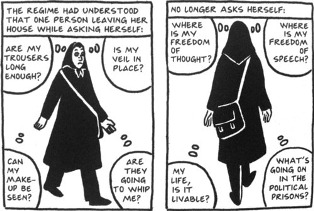As a former librarian, I
am always interested in banned books and the reason for their banning. In yet
another short-sighted move by a public school district, the banning of the book
Persepolis from the Chicago Public Schools 7th grade curriculum seems to be arbitrary.
My book club read the book in 2010 and I also watched the movie, which won an Oscar in 2008. As a matter of
fact, I gave the book to my 8th grade grandson when I was done reading it. I
found it to be profound and a terrific example of a graphic memoir.
What I find remarkable
about this whole situation is that Chicago has one of the most diverse
populations in the country, and the experiences of the author, Marjane Satrapi
when she was about 12 during the Iranian Revolution would seem to be age
appropriate as it offers a view of a culture at war. Additionally, the violence
in the book is not so far removed from the violence Chicago children are exposed to on
a daily basis. I would think that it might be comforting for children of 13 or
14 to read about how a young girl survived the violence in her country.
My grandson read Our
America: Life and Death on the South Side of Chicago as part of his ninth
grade Chicago school curriculum. In that book, two ten year old boys dropped a
5-year-old off a roof in the neighborhood where my grandson goes to high
school. How could Our America possibly be more respectable than Persepolis? i probably shouldn't speak too loudly or they will ban that book, too.
This article about the
banning appeared in today's Shelf
Awareness newsletter. Here
is my blog entry about the book.
Persepolis Ban in Chicago Boosts Graphic Novel's Sales
Last Friday, the CEO of the public
school system, Barbara Byrd-Bennett, ordered that the series be removed from
the seventh grade curriculum, and announced that CPS would also be
"reconsidering its [Persepolis] use for 8th through 10th
graders." The decision met with immediate backlash from First Amendment
activists, booksellers, Chicago residents and educators.
"The book is highly regarded by
educators and has been taught successfully in schools in Chicago and around the
country," said Joan Bertin, executive director of the National Coalition
Against Censorship. "In our view, the decision is both pedagogically
unsound and constitutionally suspect."
NCAC sent a letter to the Chicago
Board of Education condemning the move and stating, in part, "The title
character of Satrapi's book is herself the age of junior high school students,
and her description of her real-life experiences might well have special
relevance to them. The vast majority of Chicago middle school students are
surely aware of the reality of violence and its devastating effects on people
of all ages. Most have witnessed it on the news, if not in their own
neighborhoods." The letter was co-signed by the American Booksellers
Foundation for Free Expression, the Association of American Publishers, the
Comic Book Legal Defense Fund, PEN America Center and the National Council of
Teachers of English.
Many Chicago-area bookstores,
including the Book Cellar in Lincoln Square, Quimby's in Wicker Park and Women
& Children First in Andersonville, told DNAinfo that they were sold out by
the end of the weekend.
"Whatever we had, we
sold," said Suzy Takacs, owner of the Book Cellar. "It just didn't
occur to me that [the controversy] would result in sales of the book. It's not
new."
"It's a great graphic novel. I
also think it's an important book," said John Khosropour, a bookseller at
Unabridged Bookstore in Lakeview. "Whenever something gets banned, we kind
of like to push it more."
Despite the sales spike, Lynn Mooney
of Women & Children First, saw nothing to be thrilled about in regards to
the censorship. "There's no joy knowing this is going on in our city. It's
embarrassing."

